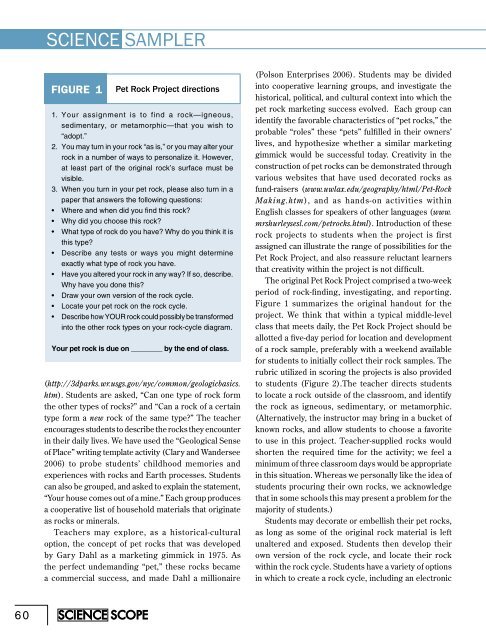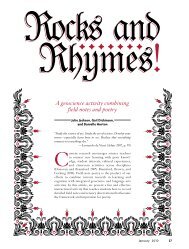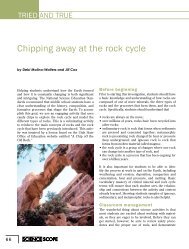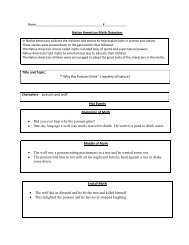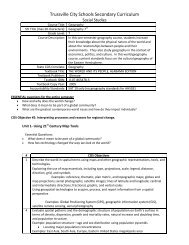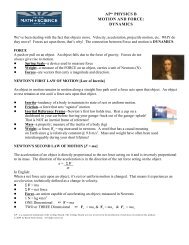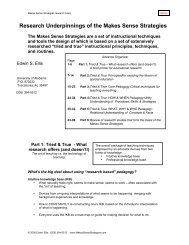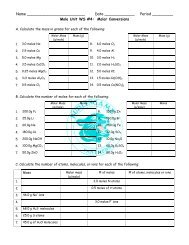The Pet Rock Project - NSTA Learning Center
The Pet Rock Project - NSTA Learning Center
The Pet Rock Project - NSTA Learning Center
Create successful ePaper yourself
Turn your PDF publications into a flip-book with our unique Google optimized e-Paper software.
SCIENCE SAMPLER<br />
FIGURE 1<br />
<strong>Pet</strong> <strong>Rock</strong> <strong>Project</strong> directions<br />
1. Your assignment is to find a rock—igneous,<br />
sedimentary, or metamorphic—that you wish to<br />
“adopt.”<br />
2. You may turn in your rock “as is,” or you may alter your<br />
rock in a number of ways to personalize it. However,<br />
at least part of the original rock’s surface must be<br />
visible.<br />
3. When you turn in your pet rock, please also turn in a<br />
paper that answers the following questions:<br />
• Where and when did you find this rock?<br />
• Why did you choose this rock?<br />
• What type of rock do you have? Why do you think it is<br />
this type?<br />
• Describe any tests or ways you might determine<br />
exactly what type of rock you have.<br />
• Have you altered your rock in any way? If so, describe.<br />
Why have you done this?<br />
• Draw your own version of the rock cycle.<br />
• Locate your pet rock on the rock cycle.<br />
• Describe how YOUR rock could possibly be transformed<br />
into the other rock types on your rock-cycle diagram.<br />
Your pet rock is due on ________ by the end of class.<br />
(http://3dparks.wr.usgs.gov/nyc/common/geologicbasics.<br />
htm). Students are asked, “Can one type of rock form<br />
the other types of rocks?” and “Can a rock of a certain<br />
type form a new rock of the same type?” <strong>The</strong> teacher<br />
encourages students to describe the rocks they encounter<br />
in their daily lives. We have used the “Geological Sense<br />
of Place” writing template activity (Clary and Wandersee<br />
2006) to probe students’ childhood memories and<br />
experiences with rocks and Earth processes. Students<br />
can also be grouped, and asked to explain the statement,<br />
“Your house comes out of a mine.” Each group produces<br />
a cooperative list of household materials that originate<br />
as rocks or minerals.<br />
Teachers may explore, as a historical-cultural<br />
option, the concept of pet rocks that was developed<br />
by Gary Dahl as a marketing gimmick in 1975. As<br />
the perfect undemanding “pet,” these rocks became<br />
a commercial success, and made Dahl a millionaire<br />
(Polson Enterprises 2006). Students may be divided<br />
into cooperative learning groups, and investigate the<br />
historical, political, and cultural context into which the<br />
pet rock marketing success evolved. Each group can<br />
identify the favorable characteristics of “pet rocks,” the<br />
probable “roles” these “pets” fulfilled in their owners’<br />
lives, and hypothesize whether a similar marketing<br />
gimmick would be successful today. Creativity in the<br />
construction of pet rocks can be demonstrated through<br />
various websites that have used decorated rocks as<br />
fund-raisers (www.uwlax.edu/geography/html/<strong>Pet</strong>-<strong>Rock</strong><br />
Making.htm), and as hands-on activities within<br />
English classes for speakers of other languages (www.<br />
mrshurleysesl.com/petrocks.html). Introduction of these<br />
rock projects to students when the project is first<br />
assigned can illustrate the range of possibilities for the<br />
<strong>Pet</strong> <strong>Rock</strong> <strong>Project</strong>, and also reassure reluctant learners<br />
that creativity within the project is not difficult.<br />
<strong>The</strong> original <strong>Pet</strong> <strong>Rock</strong> <strong>Project</strong> comprised a two-week<br />
period of rock-finding, investigating, and reporting.<br />
Figure 1 summarizes the original handout for the<br />
project. We think that within a typical middle-level<br />
class that meets daily, the <strong>Pet</strong> <strong>Rock</strong> <strong>Project</strong> should be<br />
allotted a five-day period for location and development<br />
of a rock sample, preferably with a weekend available<br />
for students to initially collect their rock samples. <strong>The</strong><br />
rubric utilized in scoring the projects is also provided<br />
to students (Figure 2).<strong>The</strong> teacher directs students<br />
to locate a rock outside of the classroom, and identify<br />
the rock as igneous, sedimentary, or metamorphic.<br />
(Alternatively, the instructor may bring in a bucket of<br />
known rocks, and allow students to choose a favorite<br />
to use in this project. Teacher-supplied rocks would<br />
shorten the required time for the activity; we feel a<br />
minimum of three classroom days would be appropriate<br />
in this situation. Whereas we personally like the idea of<br />
students procuring their own rocks, we acknowledge<br />
that in some schools this may present a problem for the<br />
majority of students.)<br />
Students may decorate or embellish their pet rocks,<br />
as long as some of the original rock material is left<br />
unaltered and exposed. Students then develop their<br />
own version of the rock cycle, and locate their rock<br />
within the rock cycle. Students have a variety of options<br />
in which to create a rock cycle, including an electronic<br />
6 0 SCIENCE SCOPE


